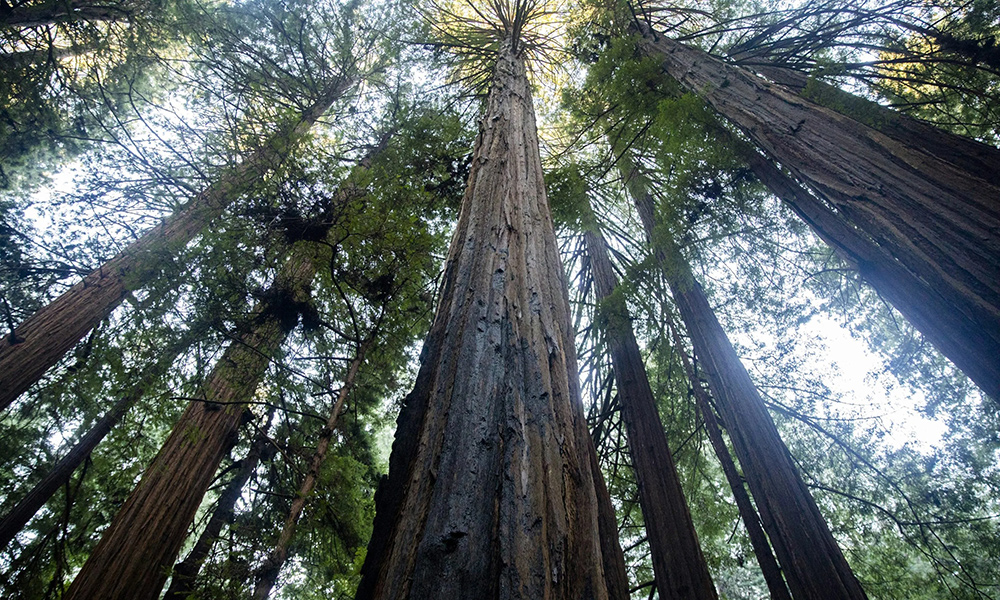美国承诺多种树以应对气候变化,但可能面临种子不足的问题

看着一棵红杉树,你很难想象它曾经是一粒小种子的样子,但这就是自然的法则,即使森林里的参天大树也要从种子成长起来。
现在,这种森林里的生命循环极其重要,因为美国计划增加植树,以应对气候变化,避免最严重的影响。
不起眼的树木能够成为解决一系列严重危机的神奇方案:森林可以吸纳空气中的二氧化碳,从而减慢气候变化,提供栖息地从而提升生物多样性,并帮助人类社区抵御高温和其他极端天气。在美国适宜植树的土地上全面重新造林,能够使美国每年的森林天然碳捕集量提高超过40%。
然而,美国并没有做好准备去释放重新造林的潜力。简而言之,美国没有足够的树种,而且收集树种的人手和培育树苗的苗圃短缺。
通过大自然保护协会(Nature Conservancy)的前沿研究,我们知道全美国在生态方面适合重新造林的土地为1.33亿英亩。重新造林的机会既有城市区域和适合发展农林业的农场,也有被烧毁的山坡和被风暴摧毁的沿岸森林。
然而,美国的苗圃目前每年培育约13亿株幼苗,每年的种植面积只足以覆盖约250万英亩土地。到2040年,即使只在具有最高优先级的土地(约6,400万英亩)上重新造林,也需要苗圃的年产量提高一倍。
随着美国各地野火持续肆虐,树种供应危机可能产生灾难性的后果。以加州为例。按照目前的球果收集速度,加州种子库用约200年时间收集的树种,也只够四分之一受近期野火影响的私人林地重新造林。公共土地面临类似的树种短缺和收集挑战。
如果这些被烧毁的土地不进行重新造林,我们就将错失碳封存的机会,并使社区面临风险。如果不重新造林,被严重烧毁的地区就将被用于种植其他植被,例如草和灌木系统等,导致自然水源供应减少。
虽然森林是我们应对气候变化最好的自然解决方案之一,但如果我们不对树种短缺问题采取干预措施,那么我们通过重新植树保护国家的能力就将大打折扣。为了应对这个不为人知的危机,我们可以共同采取以下四项措施:
利用创新能力
我们需要利用最新技术打造重新造林供应链。我们需要加快树种培育和树苗供应,开发收集和安全存储树种的新基础设施,在苗圃推广林业技术应用,并更新我们招聘和培训飞速扩张的劳动力的方式。
部署充足的资金
我们需要以前所未有的力度加大投资,无论是政府资助和贷款担保,还是私人行业的影响力投资。
我们首先能够通过获得两党赞同的《基础设施投资和就业法案》(Infrastructure Investment and Jobs Act)快速部署树种资金,包括用于提升育苗能力和策略的2亿美元。此外,《美国重新造林法案》(REPLANT)的条款将美国国家森林局(U.S. Forest Service)的重新造林资金增加了10倍。该部门可以利用这笔资金,完成积压的400万英亩重新造林工作。新签署的《通胀削减法案》(Inflation Reduction Act)有一笔15亿美元的额外资金,用于增加城市植树。
建立气候智能型种子库
为了种植能够持久的森林,我们必须保证额外收集的种子和培育的幼苗,在生物学方面符合气候适应性重新造林计划,比如美国土地管理局(Bureau of Land Management)为加州营火火迹地制定的重新造林计划。
增加植树合作
我们需要增加各州和地区之间的合作,通过促进合作提升相关能力(科学、创新和资金)。恰当的合作可以调动必要的公共和私人部门,集合从政府部门和非政府组织到苗圃老板和年轻创业者们共同努力,以实现州和区域层面的树种收集和育苗能力目标。
通过包容性的合作、数据和知识共享,综合金融支持和战略性劳动力与基础设施投资,我们能够在需求最迫切的地区,快速提升树种收集和育苗能力。
毋庸置疑,在树种收集和育苗方面以前从未有过这种程度的投资。毕竟,每一粒小小的种子都预示着一棵参天大树,它将成为自然气候解决方案,可以过滤水源,净化空气,为野生动物提供栖息地等。
我们的星球和社区迫切需要这一切。我们必须拓宽视野,增加对重新造林供应链的投资。首先,让我们从一粒“小种子”开始,找到解决问题的森林解决方案。(财富中文网)
本文作者贾德·戴利(Jad Daley)现任美国成立时间最长的森林保护非营利组织美国森林(American Forests)的总裁兼首席执行官。黄易山(Yishan Wong)现任全球森林加速组织Terraformation的创始人及首席执行官。Terraformation和美国森林最近发起了从种子到森林联盟(Seed to Forest Alliance),旨在扩大树种供应解决方案。
Fortune.com评论文章中的观点仅代表作者的个人观点,并不代表《财富》杂志的观点和立场。
译者:刘进龙
审校:汪皓
看着一棵红杉树,你很难想象它曾经是一粒小种子的样子,但这就是自然的法则,即使森林里的参天大树也要从种子成长起来。
现在,这种森林里的生命循环极其重要,因为美国计划增加植树,以应对气候变化,避免最严重的影响。
不起眼的树木能够成为解决一系列严重危机的神奇方案:森林可以吸纳空气中的二氧化碳,从而减慢气候变化,提供栖息地从而提升生物多样性,并帮助人类社区抵御高温和其他极端天气。在美国适宜植树的土地上全面重新造林,能够使美国每年的森林天然碳捕集量提高超过40%。
然而,美国并没有做好准备去释放重新造林的潜力。简而言之,美国没有足够的树种,而且收集树种的人手和培育树苗的苗圃短缺。
通过大自然保护协会(Nature Conservancy)的前沿研究,我们知道全美国在生态方面适合重新造林的土地为1.33亿英亩。重新造林的机会既有城市区域和适合发展农林业的农场,也有被烧毁的山坡和被风暴摧毁的沿岸森林。
然而,美国的苗圃目前每年培育约13亿株幼苗,每年的种植面积只足以覆盖约250万英亩土地。到2040年,即使只在具有最高优先级的土地(约6,400万英亩)上重新造林,也需要苗圃的年产量提高一倍。
随着美国各地野火持续肆虐,树种供应危机可能产生灾难性的后果。以加州为例。按照目前的球果收集速度,加州种子库用约200年时间收集的树种,也只够四分之一受近期野火影响的私人林地重新造林。公共土地面临类似的树种短缺和收集挑战。
如果这些被烧毁的土地不进行重新造林,我们就将错失碳封存的机会,并使社区面临风险。如果不重新造林,被严重烧毁的地区就将被用于种植其他植被,例如草和灌木系统等,导致自然水源供应减少。
虽然森林是我们应对气候变化最好的自然解决方案之一,但如果我们不对树种短缺问题采取干预措施,那么我们通过重新植树保护国家的能力就将大打折扣。为了应对这个不为人知的危机,我们可以共同采取以下四项措施:
利用创新能力
我们需要利用最新技术打造重新造林供应链。我们需要加快树种培育和树苗供应,开发收集和安全存储树种的新基础设施,在苗圃推广林业技术应用,并更新我们招聘和培训飞速扩张的劳动力的方式。
部署充足的资金
我们需要以前所未有的力度加大投资,无论是政府资助和贷款担保,还是私人行业的影响力投资。
我们首先能够通过获得两党赞同的《基础设施投资和就业法案》(Infrastructure Investment and Jobs Act)快速部署树种资金,包括用于提升育苗能力和策略的2亿美元。此外,《美国重新造林法案》(REPLANT)的条款将美国国家森林局(U.S. Forest Service)的重新造林资金增加了10倍。该部门可以利用这笔资金,完成积压的400万英亩重新造林工作。新签署的《通胀削减法案》(Inflation Reduction Act)有一笔15亿美元的额外资金,用于增加城市植树。
建立气候智能型种子库
为了种植能够持久的森林,我们必须保证额外收集的种子和培育的幼苗,在生物学方面符合气候适应性重新造林计划,比如美国土地管理局(Bureau of Land Management)为加州营火火迹地制定的重新造林计划。
增加植树合作
我们需要增加各州和地区之间的合作,通过促进合作提升相关能力(科学、创新和资金)。恰当的合作可以调动必要的公共和私人部门,集合从政府部门和非政府组织到苗圃老板和年轻创业者们共同努力,以实现州和区域层面的树种收集和育苗能力目标。
通过包容性的合作、数据和知识共享,综合金融支持和战略性劳动力与基础设施投资,我们能够在需求最迫切的地区,快速提升树种收集和育苗能力。
毋庸置疑,在树种收集和育苗方面以前从未有过这种程度的投资。毕竟,每一粒小小的种子都预示着一棵参天大树,它将成为自然气候解决方案,可以过滤水源,净化空气,为野生动物提供栖息地等。
我们的星球和社区迫切需要这一切。我们必须拓宽视野,增加对重新造林供应链的投资。首先,让我们从一粒“小种子”开始,找到解决问题的森林解决方案。(财富中文网)
本文作者贾德·戴利(Jad Daley)现任美国成立时间最长的森林保护非营利组织美国森林(American Forests)的总裁兼首席执行官。黄易山(Yishan Wong)现任全球森林加速组织Terraformation的创始人及首席执行官。Terraformation和美国森林最近发起了从种子到森林联盟(Seed to Forest Alliance),旨在扩大树种供应解决方案。
Fortune.com评论文章中的观点仅代表作者的个人观点,并不代表《财富》杂志的观点和立场。
译者:刘进龙
审校:汪皓
It is hard to look at a redwood and imagine that it was once a tiny seed, but it is a simple truth of nature that even our forest giants have to start small.
This forest life cycle is extremely important right now, as our nation looks to plant more trees to act against climate change and protect us from its worst impacts.
The humble tree is a magic solution to a set of colliding crises: Forests pull carbon dioxide from the air to slow climate change, provide habitat that supports biodiversity, and shelter our communities from heat waves and other extreme weather. Reforesting the full extent of suitable land in the U.S. would increase natural carbon capture in forests by more than 40% each year.
However, we’re not ready to meet this reforestation potential. To put it simply, there are not enough seeds, people to collect them, and nurseries to grow them.
Thanks to cutting-edge research from the Nature Conservancy, we know there are 133 million acres of ecologically suitable land for reforestation across America. These opportunities extend from urban areas and agroforestry-friendly farms to burned mountainsides and coastal forests devastated by windstorms.
However, American nurseries currently produce roughly 1.3 billion seedlings annually, which is only enough to plant approximately 2.5 million acres per year. Even to reforest only the highest priority lands (roughly 64 million acres) by 2040, we would need to double annual nursery production.
And with wildfires on the increase across the country, this seed supply crisis has potentially catastrophic consequences. Take California, for example. At the current pace of cone collection, it would take the state seed bank almost 200 years to collect the seeds needed to reforest just a quarter of private forest lands affected by recent wildfires. Public lands face similar scarcity and collection challenges.
If we fail to reforest these burn scars, we’re not just missing out on an opportunity to sequester carbon, we’re also putting communities at risk. Without reforestation, severely burned areas transition to other vegetation types, such as grass and shrub systems that decrease the natural water supply.
While forests are among our best natural solutions to climate change, the ability to protect our nation through reforestation will only decrease unless we intervene in this seed shortage. Here are four steps we can take together to tackle this quiet crisis:
Use the power of innovation
We need to develop a reforestation supply chain that leverages technology. We need to grow seed and seedling supply faster, develop new infrastructure for seed collection and safe storage, enhance forestry techniques used in tree nurseries, and update how we recruit and train a dramatically expanded workforce.
Deploy ready funding
We need an unprecedented wave of investment, from government grants and loan guarantees to private-sector impact investing.
We can start by quickly deploying the dollars for seeds secured by the bipartisan Infrastructure Investment and Jobs Act, which includes $200 million specifically for nursery capacity and strategy, and a REPLANT provision that increases U.S. Forest Service reforestation funding 10-fold, which the agency can use to close a 4-million-acre reforestation backlog. The newly signed Inflation Reduction Act has additional funds, including $1.5 billion to expand tree canopy in our cities.
Build a climate-smart seed collection
To regrow forests to last, we must make sure the additional seeds we collect and seedlings we grow are biologically aligned with climate-resilient reforestation plans, like the one developed by the Bureau of Land Management for the Camp Fire Burn Scar in California.
Grow partnerships to grow trees
We need to develop state and regional partnerships that integrate these capacities (science, innovation, and funding) by facilitating collaboration. The right kind of partnership can integrate all needed public and private actors, from government agencies and NGOs to nursery owners and young ecopreneurs, to work together toward specific targets in seed and seedling capacity at the state and regional levels.
Through inclusive collaboration, data and knowledge sharing, integrated finance, and strategic workforce and infrastructure investments, we can quickly multiply seed and seedling capacity where it’s most needed.
It is perhaps no surprise that this level of investment in seeds and seedlings has not happened before. After all, a tiny seed is just the hint of the tree that is to come—a tree that will be a natural climate solution, a water filter, an air purifier, a wildlife habitat, and so much more.
Our planet and our communities desperately need all of that. We must broaden our perspective and invest in every inch of the reforestation supply chain. First, let’s think “seed small” so we can go big on forest solutions.
Jad Daley is president and CEO of American Forests, the nation’s oldest forest conservation nonprofit. Yishan Wong is founder and CEO of Terraformation, a global forest accelerator. Terraformation and American Forests recently launched the Seed to Forest Alliance to scale seed supply solutions.
The opinions expressed in Fortune.com commentary pieces are solely the views of their authors and do not necessarily reflect the opinions and beliefs of Fortune.













